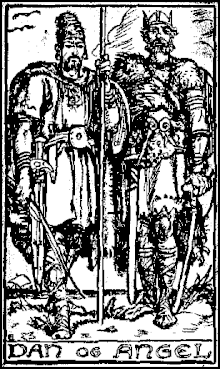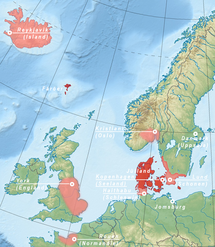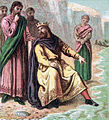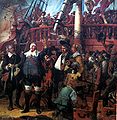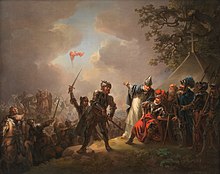Danes

The Danes are a Germanic people in Northern Europe . You are the titular nation of the Kingdom of Denmark and a recognized minority in Schleswig-Holstein ( Südschleswig ).
The totality of Danish citizens must be distinguished from ethnic group ; except for naturalized immigrants and a German-speaking minority in South Jutland ( North Schleswig ) have Faroese and Greenlandic (Greenland Inuit ) Danish nationality because the Faroe Islands and Greenland parts of the kingdom.
language

The Danish language is a North Germanic language . It separated from the other Scandinavian (North Germanic) or Old Norse languages between the 10th and the 13th or 14th centuries . The main triggers for this were political and social reasons.
Standard Danish , based on the Copenhagen or Zeeland dialect, emerged by the middle of the 16th century . There are also several Danish dialects , such as Island Danish , Jutlandic and East Danish (Scandinavian). Up until the language change in the 19th century, Anglo-Danish was still widespread in parts of Schleswig ; the last record of the dialect was made in the 1930s.
In Flensburg there is still a German-Danish mixed language, the Petuh . Within the Danish minority, southern Schleswig- Danish, which is influenced by the northern German colloquial language, has also developed.
The Scandinavian language (shown in blue on the map), which is widespread in southern Sweden (Scania), is very closely related to Danish. In fact, opinions differ as to whether Scania is a southern Swedish or an eastern Danish dialect.
History of the Danes
Synonymous with “ Normans ” in medieval Western Europe, all Vikings were initially referred to as “Danes” - regardless of whether they were Danish, Norwegian or Swedish Vikings. The name "Denmark" first appeared around 900 among the travelers Wulfstan and Ottar . The word means something like "borderland of the Danes" ( Mark in the sense of "border") and originally referred, depending on the theory, to the southern border area on the Eider or to the Danish islands and Skåneland . Each of these interpretations is controversial.
Historical rune stone in Danmark , Uppsala (Sweden) - the mythical original home of the Danes
Legend has it that Odin's son Skiold was the progenitor of the Danes and ended up in Jutland
The legendary Battle of Bråvalla was the first climax of Swedish-Danish hostility
Dan's great-grandson Hrothgar is portrayed in the old English epic Beowulf (8th century)
Etymology and Mythology
There are more legends than reliable information about the origin of the Danes. The Norman chronicler Dudo von Saint-Quentin wanted to see the Danes as descendants of the Trojan Antenor . According to their own tradition (recorded in the Gesta Danorum ), their progenitor was a king named Dan . Other legends made Odin's son Skjöld the progenitor of the Danes or the ancestor of the Danish royal house of the Skjöldungar (Skioldinger), some of them in turn referred to Skjöld as the grandson of Dan. Dan had a brother named Angul , who is considered the ancestor of the Angles . In other traditions there is a third brother named Nór (i) , the legendary ancestor of the Norwegians , and a fourth named Østen (Chronicon Lethrense). They are all said to have been sons of the king of Old Uppsala . In fact, there is still a place in the Uppsala municipality called Danmark in the Uppland province , which is said to be associated with the legendary original home of the Danes.
The Roman - Gothic chronicler Jordanes first mentioned the Dani (Danes, Dannen) in his Getica around 550 as a sub-tribe of the Suitidi ( Sithons ), i.e. the Swedes . At the same time, the Danes also appeared in the histories of the Greek historian Prokop , in which he reported on the Gothic Wars. Jordanes and Procopius brought the Danes in connection with them supposedly related in their reports Herulians . These are said to have been expelled from their settlement areas in Skåne and Halland by the Danes. The Herul king Rudolf founded a new empire on the Danube . When it was destroyed by the Lombards , the Heruli moved back to Scandinavia or Jutland around 512, where they are said to have been absorbed by the Danes. Whether the Heruli actually came from Scandinavia, whether they were Teutons at all and, above all, whether and how they actually migrated back to Scandinavia is controversial.
The Franconian chronicler Gregor von Tours described in his "History of the Franks" around 590 the campaign of a Danish king named Chlochilaicus into the Franconian Empire , which is said to have taken place around 515 or 521. The Finnsburg fragment , a remnant of an old English poem, which was only created in the 7th century , tells of battles between Danes and Frisians in the middle of the 5th century. In the old English Beowulf epic of the 8th century, the Danes were mentioned as Gâr-Dena ( Ger- Danes, i.e. "Spear Danes"). In other medieval tales, Ring Danes ( armed with ring armor ), Sword Danes , Ax Danes , Hammer Danes , etc. were occasionally mentioned.
Ethnogenesis and land acquisition

At the beginning of the 6th century, the Danes from Scania first spread to Zealand and the other Danish islands, and from there in the middle of the 6th century to Jutland . In Jutland, the North Germanic Danes merged with the remnants of the pre-population from North West Germanic ( Ingvaeon ) Jutes and Angles who had not migrated to England in the previous century . However, from the 7th to the 11th centuries the Danes in Jutland and Schleswig had to assert themselves against Norwegian and Swedish attempts to conquer and settle. From the 9th century onwards, Danish Vikings moved to England (especially to the kingdoms of Northumbria , Mercia and East Anglia, which were once founded by the Anglers ) and Ireland. Lincoln , Derby , Nottingham , Leicester and Stamford were Danish cities (" Fünfburgenland ").
Most of the Vikings (hereafter called Normans ) who settled in French Normandy in the 9th and 10th centuries were Danes. Despite the English St. Brice's Day massacre of Danish settlers (1002), the Danes briefly ruled over the whole of England and thus over a North Sea region in the 11th century , but were just as quickly absorbed into the English population as the Normans were assimilated by the French .
The first historically tangible Danish king and first provisional unifier was Gudfred in Haithabu . At the beginning of the 9th century , the Frankish emperor Charlemagne set up the Danish mark (Mark Schleswig) between Schlei and Eider against him . The Danes, for their part, built the Danewerk against the Franks and Saxons , which developed into a national defense system or a national symbol. From then on, the Eider formed the approximate southern border of the Danish settlement. In addition, Danish Viking princes, baptized vassals of Frankish rulers, ruled Dorestad (near Utrecht) and most of Friesland in the 9th century . However, there was no submission of the Frisians, a Danish conquest and the possibly intended establishment of a Danish-Scandinavian colony or a subsidiary empire in Friesland. It was only under King Gorm in the first half of the 10th century that the Danish empire was unified. Imperial unity was briefly lost again in the first half of the 12th century and in the first half of the 14th century.
In the course of political differentiation, independence and mutual demarcation of the three Nordic peoples from one another, between the 11th and 16th centuries the Danes, different from Swedes and Norwegians, finally emerged. In the 14th century, large parts of the Frisian or Danish settlement area on the Schleswig-Holstein North Sea coast sank permanently in the stormy sea, Denmark lost tens of thousands of inhabitants and habitat for tens of thousands more. The Danes lost their Skåne homeland to Sweden in the 17th century, but began colonizing Greenland in the 18th century.
Nation state and national consciousness

While the Swedish national consciousness arose mainly through the demarcation and difference from Danishism, the Danish national consciousness is mainly characterized by self-assertion and emancipation towards the German neighbors. The Danewerk already emerged as a joint national defense effort against the East Franconian and German Empire, and the pagan restoration attempts under Sven Gabelbart were primarily directed against the growing influence of German missionaries. With the shaking off of the feudal oath repeatedly enforced against the German Emperor in the 9th, 10th, 11th and 12th centuries, King Waldemar I and his son Knut VI established the foundation . a first Danish period of great power, which was later transfigured. In the 13th, 14th and 15th centuries, however, the Danish great power had to defend itself against the domination of the German Hanseatic League, which repeatedly plundered and bombed Copenhagen. It was not until the 16th century that the German League of Cities was defeated.
Under Christian IV , Denmark reached the height of cultural and scientific heyday at the beginning of the 17th century, but its religious sense of mission failed in the Thirty Years' War and led to the occupation of Jutland by imperial German mercenaries. Christian's heroism in battle is sung about in the royal Danish national anthem . After that Denmark was initially engaged in the self-assertion struggle against Sweden. With the Peace of Roskilde in 1658, Denmark had to cede its eastern provinces of Schonen , Blekinge and Halland ( Skåneland ) to Sweden , which made the capital Copenhagen , which had been centrally located , a border town. At the beginning of the 18th century Denmark had to give up its plans to recapture the Swedish annexed ancestral lands in Skåne. With the loss of Norway to Sweden at the beginning of the 19th century , the entire Danish state was finally limited to Denmark, Schleswig-Holstein and the North Atlantic possessions.
Canute the Great († 1035) ruled the North Sea, Christianized the Danes and won Holstein
Waldemar the Great († 1182) threw off German feudal sovereignty and conquered Rügen
Denmark flourished under Christian IV († 1648), but lost control of the Baltic Sea
Christian X. († 1947) maintained national awareness during the German occupation
Already at the end of the 18th century, laws by the Minister Ove Høegh-Guldberg had upgraded the Danish language and culture or pushed back the great German influence in the kingdom. The seed for a modern national consciousness directed against Germany was laid and was expanded and further developed by a romantic component in the religious-conservative adult education centers established on the initiative of Nikolai Grundtvig in the mid-19th century . On the Schleswig-Holstein question , German and Danish nationalism clashed in the middle of the 19th century. The Danish National Liberals ( Eiderdänen ) wanted Schleswig, which had the status of a Danish fiefdom, to constitutionally integrate into the Danish heartland as far as the German-Danish border at the time on the Eider or to the Danewerk, and to do so through a personal union with Denmark, but separate and give up Holstein otherwise belonging to the German Confederation. Another national liberal variant was Scandinavianism , which formulated an all-Nordic identity. Opposite them stood both the German national liberals in the duchies (Schleswig-Holstein movement) and the conservative-paternalistic supporters of the state (Helstatsfolk) who wanted to preserve the multi-ethnic state and its previous order.
Ove Høegh-Guldberg († 1808) secured the supremacy of the Danes in the entire state
Nikolai Grundtvig's († 1872) elementary schools promoted religious nationalism
Orla Lehmanns († 1870) Eider Danes took anti-German positions
Frederik Barfods († 1896) Pan- Scandinavian nationalism reconciled Danes and Swedes
In the German-Danish War Denmark finally lost Schleswig and Holstein to Germany in 1865, from then on a Danish minority lived outside the kingdom. Only after the First World War did the north of Schleswig come back to Denmark. The absolute low point in the history of Danish-German relations , however, was not brought about until the German occupation of neutral Denmark during the Second World War (1940–1945). While several thousand collaborators in Danish SS units supported Nordic - Pan-Germanic nationalism and National Socialism (including many members of the German minority in Northern Schleswig), national resistance was formed against the occupiers and their collaborators. It was not by chance that the most important resistance group was called Holger Danske . Mistrust and anti-German prejudices were heightened by the occupation and persisted into the 1990s. Resentment of this kind has also had an impact on Danish European policy; many Danes fear foreign infiltration by the more numerous Germans in a larger Europe .
With the constitution of 1953, the Greenland Inuit were considered Northern Danes . Especially in the 1960s and 1970s, Denmark's social democratic governments pursued a policy of danization towards them, which aimed at integrating the Inuit into the welfare state; they should be forced to settle down. After the government was taken over by a right-wing liberal-conservative coalition, domestic politics under Anders Fogh Rasmussen was shaped by his 2003 slogan of the culture war against an overgrown state and against the influence of Danish cultural radicalism, which was a polarization between nationalist and cultural radical-modernist positions was recognizable. Rasmussen stated that Denmark is not and does not want to be a multi-ethnic country. The influence of the right-wing populist Dansk Folkeparti , which supported the right-wing conservative minority government in parliament, also became evident with the tightening of the asylum laws, which were previously expanded under the Social Democratic government, the restriction of family reunification for foreigners living in the country and the reintroduction of permanent border controls . The Mohammed cartoons for the Danish newspaper Jyllands-Posten also fell during this period .
religion
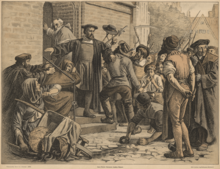
The Frankish bishop Eligius is said to have sent missionaries to the Danes as early as the 7th century , and between 699 and 725 the Anglo-Saxon missionary Willibrord of Utrecht preached among the Frisians in Jutland and at the court of the Danish king Angantyr . According to a Danish legend, around 810, Holger Danske was forced by Charlemagne to accept Christianity. (As Charles's vassal, Holger then conquered and Christianized India before he returned.) In 823 Ebo from Reims came to Denmark as the first papal missionary. As the first Danish king, Harald Klak is said to have been baptized as early as 826, but the remaining Danes initially stuck to the old North Germanic faith despite the missionary attempts of Saint Ansgar from Hamburg and Bremen , numerous churches were destroyed again, and Christian Danes emigrated to Friesland. In 845 Danish Vikings also destroyed the Hamburg Mission Center. In conquered England, however, the Danish Vikings under Guthrum had adopted Christianity around 878, as had Godefried in Friesland in 881 and the Danish-Norwegian Viking kings in Ireland in 926 at the latest . Around 911 the Danish Vikings in Normandy and their leader Rollo were also baptized. An uprising by the Danes in Normandy against Christianization was put down in 943.
Mid-10th century, the Lower Saxony Bishop were Unni and the Frisian missionary Poppo in Denmark successful: First, to 934 defeated warägische King Knut I. Hedeby be forced converted to Christianity. The Warsaw merchants in Haithabu had recognized the advantage of the new religion in dealing with Christian trading partners earlier. In Schleswig (Haithabu), Ripen and Aarhus , Denmark's first dioceses were established in 948. Gorm's son Harald Blauzahn , who still supported the pagan uprising in Normandy in 943, was baptized by Poppo around 965. A restoration of the old religious beliefs, endeavored by Harald's son Sven Gabelbart , failed; Sven's son Knut II brought English missionaries to Denmark at the beginning of the 11th century. As a result, the Danes were Christianized, so that Knut's nephew Sven Estridsson replaced the English clergy with Danish ones in the second half of the 11th century. Sven's son took part in the First Crusade in 1097 , and the church-friendly King Canute IV was canonized in 1101. With the establishment of an archbishopric in Lund , the Danish church broke away from Hamburg and Bremen in 1104, and Danish kings now began their own crusades to convert the Wends (conquest of Rügen in 1168). On a crusade to Estonia in 1219 the Christian Danes are said to have been sent the Dannebrog , today's national flag, down from heaven.
After his deposition in Sweden and Denmark (1523), the former Union King Christian II converted to the Lutheran faith and published the first translation of the Gospel into Danish. Under him the state union with Sweden ( Kalmarer Union ) came to an end, although Protestant Christianity was also introduced in Sweden in 1527/31. At the same time, the Lutheran Hans Tausen began to preach Reformation in Denmark. With the suppression of the Catholic opposition in Norway and the introduction of the Reformation in Denmark by Christian III. in 1536 the Danish population finally became Evangelical Lutheran . In order to restructure the old Danish church and build a new national church, Christian III brought. Luther's companion Johannes Bugenhagen from Germany to Denmark. The 1550 translation of the Bible codified the standard Danish language. During the Thirty Years' War in 1625, Christian IV even felt called to be the savior and champion of Protestant Christianity in the German Empire.
The Christianization of the Danes and Swedes began around 830 with Saint Ansgar
King Harald Blauzahn was baptized by the Frisian missionary Poppo around 965
King Canute IV was canonized in 1101 and was Denmark's patron saint
Christian II, last Union king and first Lutheran (portrayed by Lucas Cranach, 1523)
In 2018, 77 percent of Denmark's population was considered Protestant, in 2012 it was at least 80 percent, and at the end of the 1990s it was even more than 90 percent. The trend is falling, and barely 5 percent of all Danes go to church regularly. The Danish national church enjoys a privileged position in the Basic Law of Denmark , which is similar to that of a state church . The Evangelical Lutheran faith is officially no longer the state religion , but the royal head of state must be Lutheran. In his capacity as head of the Danish Church, the king is also responsible for appointing the bishops.
Danes outside Denmark
The majority of the 5.5 to 6 million ethnic Danes live in Denmark . Here they make up about 95% of the population. In contrast, the ethnic Danes are only a minority in the autonomous regions, in Greenland with 11.2% of the population and in the Faroe Islands with 5.8%.
Danes in Northern Germany
In Schleswig-Holstein there is a Danish minority that has its own political representation in the form of the South Schleswig voter association SSW and is organized in numerous Danish parishes, cultural and sports associations. There are also Danish schools and kindergartens. In Germany, the Danish people from southern Schleswig are recognized as a national minority . According to earlier information from the Schleswig-Holstein state parliament , their number should be 50,000. There are over 20,000 members organized in Danish associations. Over 10,000 residents in the Schleswig region speak Danish as their mother tongue, but far more as a second language. In March 2015, however , the University of Hamburg published a survey-based study according to which the Danish minority in northern Germany, with 100,000 members, is twice as large as previously assumed. In Hamburg alone there are 25,000 Danes; 37,000 Danes live in Holstein and 42,000 in Schleswig.
Danes in Northern Europe
In Denmark's northern neighbors Sweden and Norway there are both long-established Danish minorities and immigrant Danish citizens: at least 38,000 Danes live in Sweden; 12,000, 15,000, 18,000 or 20,000 Danes live in Norway, depending on the source. Almost 1,300 other Danes live in the former Danish possession of Iceland .
Danes in North America

The United States , Canada , Australia , Brazil , Argentina, and the United Kingdom have greater numbers of residents of Danish descent. For the USA, 160,000, 190,000 or 320,000 Danes are listed, depending on the source. In 1790 only around 8,000 Danes (and just as many Norwegians) lived in the United States. Today's Americans of Danish descent are primarily descendants of Danish emigrants of the 19th and 20th centuries. Compared to Sweden and Norway, however, emigration from Denmark was minor. Between 1820 and 1993, a total of 372,000 Danes emigrated to the United States. The United States Census 2000 counted over 1.43 million descendants of Danish emigrants, over 200,000 of them in California . In 1990 there were 1.63 million people of Danish origin in the USA. But hardly 30,000 of them still spoke Danish as their mother tongue. For Canada, 90,000 to 200,000 Danes or people of Danish origin are given, for Australia 6000 or over 50,000.
literature
- Benito Scocozza, Grethe Jensen: Politics Etbinds Danmarkshistorie . 3rd edition edition. Politics Forlag, 2005, ISBN 87-567-7064-2 , p. 236 ff .
- Günter Neumann , Elias Wessén : Danes. In: Reallexikon der Germanischen Altertumskunde (RGA). 2nd Edition. Volume 5, Walter de Gruyter, Berlin / New York 1984, ISBN 3-11-009635-8 , pp. 174-177.
Web links
- Bonn Declaration on the Danish Minority of 1955 ( Memento of May 13, 2005 in the Internet Archive ) (PDF; 256 kB; 4 pages)
- Institute for Border Region Research: The rights of national minorities in the German-Danish border region ( Memento from April 15, 2007 in the Internet Archive ) (PDF; 169 kB; 69 pages)
- Institute for Border Region Research: From National Conflict to Peaceful Coexistence and Cooperation ( Memento from March 6, 2007 in the Internet Archive ) (PDF; 636 kB; 58 pages)
Individual evidence
- ↑ a b Danish language . In: Meyers Konversations-Lexikon . Third edition, Leipzig 1875, fourth volume, p. 904 f.
- ↑ a b c d e Detlev Wahl: Lexicon of the peoples of Europe and the Caucasus . Meridian-Verlag, Rostock 1999, p. 48 ff.
- ↑ Heinz F. Wendt: The Fischer Lexicon Languages . Frankfurt (Main) 1961, p. 98.
- ↑ a b c d e Willi Stegner (Hrsg.): Pocket Atlas Völker und Sprachen . Klett-Perthes, Gotha / Stuttgart 2006, pp. 38–41.
- ↑ Harald Wolbersen: The Danish language in the fishing region . In: NordeuropaForum . 2015, p. 30 and 34 .
- ^ Rudolf Simek: The Vikings . CH Beck, 1998, ISBN 978-3-406-41881-5 , pp. 29 f . ( limited preview in Google Book search).
- ↑ Benito Scocozza, Grethe Jensen: Politikens Etbinds Danmark history . 3. Edition. Politics Forlag, 2005, ISBN 87-567-7064-2 , p. 44 .
- ↑ a b c d Johannes Hoops, Heinrich Beck: Danes . In: Reallexikon der Germanischen Altertumskunde . Walter de Gruyter, Berlin / New York 1984, Volume 5, pp. 174-177.
- ↑ Hubert Houben: The Normans . CHBeck, Munich 2012, p. 14.
- ↑ Skjold . In: Christian Blangstrup (Ed.): Salmonsens Konversationsleksikon . 2nd Edition. tape 21 : Schinopsis spectrum . JH Schultz Forlag, Copenhagen 1926, p. 587 (Danish, runeberg.org ).
- ^ Wilhelm Wägner: Our prehistory , Volume 1 (Germanic legends of the gods). Neufeld and Henius Verlag, Berlin 1922, p. 223 f. and 256 ff.
- ↑ Dan . In: Christian Blangstrup (Ed.): Salmonsens Konversationsleksikon . 2nd Edition. tape 5 : Cikorie – Demersale . JH Schultz Forlag, Copenhagen 1916, p. 509 (Danish, runeberg.org ).
- ↑ James William Barnes Steveni : Unknown Sweden . London / Southampton 192, pp. 39, 170 and 3225.
- ↑ Ulla Ehrensvärd, Pellervo Kokkonen, Juha Nurminen: The Baltic Sea - 2000 years of seafaring, trade and culture . National Geographic, Hamburg 2010, p. 31.
- ^ Friedrich Christoph Schlosser, Gottlieb August Bercht: Archive for History and Literature . Siegmund Schmerber, Frankfurt (Main) 1833, Volume 6, pp. 177f, 187f and 209f.
- ↑ a b c Erich Hoffmann: Historical evidence of the Danish immigration in the 6th century . In: Edith Marold , Christiane Zimmermann: Northwest Germanic . Walter de Gruyter, Berlin / New York 1995, pp. 77-90.
- ↑ Alois Wolf: heroic saga and epic . Gunter Narr Verlag, Tübingen 1995, pp. 88-91.
- ↑ z. B. the Norwegian King Olaf Trätelgja , the Swedish King Sigurd Ring , the Norwegian Ynglinger, the Swedish House Olaf, the Swedish King Erik Segersäll and the Norwegian King Magnus Olafsson .
- ↑ z. B. the Swedish warehouseman from Haithabu.
- ^ Karl Ploetz: Extract from the story . Ploetz, Würzburg 1962, p. 163.
- ^ Denmark: History . In: Meyers Konversations-Lexikon . Fifth edition, Leipzig 1897, fourth volume, p. 558.
- ^ Norway: History . In: Meyers Konversations-Lexikon . Third edition, Leipzig 1877, twelfth volume, p. 129.
- ↑ James William Barnes Steveni: Unknown Sweden . London / Southampton 1925, p. 325 f.
- ^ Hermann children, Werner Hilgemann: dtv atlas for world history . Deutscher Taschenbuch Verlag, Munich 1990, Volume 1, p. 128 f.
- ↑ a b c Harald Haarmann : Small Lexicon of the Peoples: from Aborigines to Zapotecs . Beck, Munich 2004, p. 107 f.
- ^ Henri Pirenne: History of Europe - From the Migration Period to the Reformation . Fischer, Frankfurt (Main) 1982, p. 115.
- ^ Henri Pirenne: History of Europe - From the Migration Period to the Reformation . Fischer, Frankfurt (Main) 1982, p. 625.
- ^ Robert Bohn: Danish history . CH Beck, Munich 2001, p. 81f.
- ^ Harm G. Schröter: History of Scandinavia . CH Beck, Munich 2007, p. 51.
- ^ Robert Bohn: Danish history . CH Beck, Munich 2001, p. 98.
- ↑ In the Schleswig Wars, for example, volunteers from Sweden and Norway also fought on the Danish side.
- ^ Harm G. Schröter: History of Scandinavia . CH Beck, Munich 2007, p. 90.
- ^ Robert Bohn: Danish history . CH Beck, Munich 2001, p. 116f.
- ↑ TIME 44/1996 of 25 October 1996: At the Danish drip
- ↑ Heiko F. Marten: Language Policy - An Introduction , page 84. Narr Francke Attempto Verlag, Tübingen 2016
- ↑ Cevia (a liberal think tank): Borgerlig kulturkamp og opgør med det kulturradISCHE dannelsesprojekt ( Memento of the original from November 2, 2014 in the Internet Archive ) Info: The archive link has been inserted automatically and has not yet been checked. Please check the original and archive link according to the instructions and then remove this notice.
- ^ A b Jens-Martin Eriksen, Frederik Stjernfelt: Culture as political ideology . In: perlentaucher.de - the culture magazine from October 26, 2010.
- ^ Harm G. Schröter: History of Scandinavia . CH Beck, Munich 2007, p. 118.
- ^ Thorning: Reform-tempo måske for højt . Danmarks Radio
- ↑ Phillip Pulsiano, Kirsten Wolf: Medieval Scandinavia - An Encyclopedia . Taylor & Francis, 1993, p. 404.
- ↑ Hubert Houben: The Normans . CH Beck, Munich 2012, p. 16 f.
- ^ Rudolf Simek: The Vikings . CH Beck, Munich 1998, pp. 125 and 127.
- ^ Robert Bohn: Danish history . CH Beck, Munich 2001, p. 24.
- ^ Harm G. Schröter: History of Scandinavia . CH Beck, Munich 2007, p. 28.
- ↑ The New Fischer World Almanac 2019 . Frankfurt 2018, p. 103
- ↑ International Religious Freedom Report for Denmark (2012)
- ↑ Josef Joffe : God is American . In: Die Zeit , No. 9/2011.
- ↑ minority government. Schleswig-Holstein State Parliament, archived from the original on September 7, 2005 ; Retrieved October 31, 2009 .
- ↑ The Danish language. Danish Cultural Institute, Bonn, accessed on October 31, 2009 .
- ↑ shz.de of March 25, 2015: 100,000 Danes live in SH and Hamburg
- ↑ Press releases of the University of Hamburg from March 25, 2015: Danish minority in Germany larger than previously assumed ( Memento of the original from April 17, 2015 in the Internet Archive ) Info: The archive link has been inserted automatically and has not yet been checked. Please check the original and archive link according to the instructions and then remove this notice.
- ↑ a b c d e J.W. Bromlej: народы мира - историко-этнографический справочник (peoples of the world - historical-ethnographic words / handbook). Moscow 1988, p. 151 f.
- ^ Central Statistical Bureau of Norway (2009).
- ^ Ploetz Great Illustrated World History . Ploetz, Freiburg / Würzburg 1984, Volume 6, p. 239.
- ↑ Johannes Riedel: Knaur's World Atlas . Berlin 1936, p. 126.
- ↑ Otto Johnson: Information please! Almanac, Atlas and Yearbook 1995 , p. 832. Houghton Mifflin Company, Boston and New York 1995.
- ^ Page of the "United States Census 2000" at the United States Census Bureau (English).
- ↑ Otto Johnson: Information please! Almanac, Atlas and Yearbook 1995 . Houghton Mifflin Company, Boston / New York 1995, p. 834 f.
- ^ Ethnocultural Portrait of Canada
- ^ Australian Bureau of Statistics (2003).




